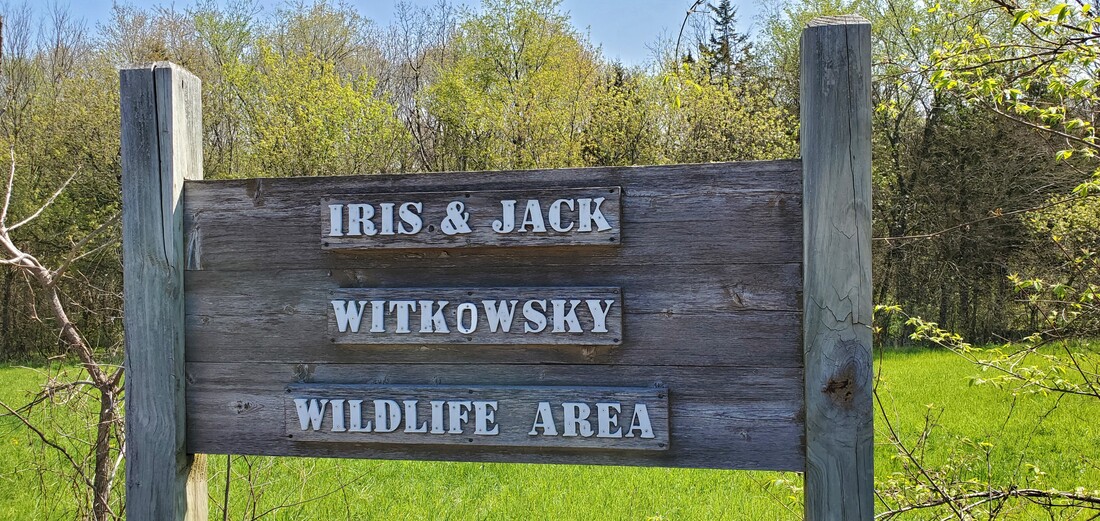We spot our first bird at 6:18 a.m., a killdeer hopping through the Piggly Wiggly parking lot in Galena. “We’re not in our territory yet,” says Chris, “so we can’t count it.”
Four of us had met up on an early May Saturday morning to participate in the Jo Daviess County Conservation Foundation’s (JDCF) annual spring bird count: Chris Larson, Laurie Mattas, my wife Dianne, and me. Chris and Laurie were experienced birders and Board members of the JDCF. Dianne and I were along as novices.
We would be among thirty or so birders divided into ten teams, each with its own “territory” throughout the county in which to count birds and bird species. The results would then be tallied county-wide and submitted to a national data base recording the findings of spring bird observers all across the nation.
JDCF Executive Director Steve Barg describes the task as “citizen science.” With the compiled information, scientists can track population trends—declines or increases or movements of species over time. “Imagine if you had to pay 30 people in every county, every state, to do this. It couldn’t be done,” says Barg.
Our territory takes us first south out of Galena along Blackjack Road. We crawl along the road at a snail’s pace in Laurie’s Honda CRV, alerting drivers who come up behind us with a red “Bird Count Team” sign in the rear window. Laurie scores our first tally: a wren on a telephone wire.
The tally sheet fills with checkmarks as we leave Blackjack and climb the entrance road to Horseshoe Mound Preserve. We see plenty of redwing blackbirds and robins along the road, of course, but also a kestrel on a telephone wire, two bluejays, and a meadowlark.
Exiting the car at the Preserve, Chris and Laurie listen first for the bird calls and then pick out the birds within a “Where’s Waldo” backdrop of trees and bushes. “You learn to filter out the more common sounds, then listen for what’s different,” says Chris. Mnemonics help. Hearing a consistent calling of “Drink your Tea-ea-ea!,” Chris soon spies six Eastern Towhees, more than she’s ever seen in one place.
Laurie also spots a Towhee: “I’ve never seen one, so that’s new for me. See, he’s sitting on that low branch, waiting for someone. ‘Come find me, I’m cute!’”
Our path next takes us along Irish Hollow and several connecting roads. Sometimes we stop and walk a productive area, but frequently we drive slowly along the county roads, spying birds in treetops, fence lines, creeks, and at homeowners’ front-yard bird feeders.
We spot a great blue heron tracing a creek through a valley. Laurie directs our attention to a cardinal’s “pew-pew-pew.” Ten cedar waxwings decorate a pine like flitting ornaments. “You can see the white bands in their wings,” says Laurie. Two chickadees. A red-tailed hawk in a tree branch.
The day is ideal for birding. On a sunny morning we are a week past the last snowfall, before the trees have fully leafed out. And we are in a particularly rich environment, in the Driftless region and along the Mississippi River corridor. “There is a huge variety of bird species here because of the terrain,” Laurie explains, noting, too, that we are still in season for neo-tropical migrant birds.
Jo Daviess County both reflects and runs contrary to trends across the country. In assessing the data, JDCF Director Barg says, “We look for birds we know are Illinois ‘species of concern,” i.e., those not currently listed as threatened or endangered but known to be in decline, such as red-headed woodpeckers, bobolinks, Henslow’s sparrows. “With climate change, we are seeing that birds whose northern range used to be southern Illinois are now much farther north.” But Barg adds that while some of these trends are likewise apparent in Jo Daviess County, in other cases birds that are becoming rare elsewhere are still thriving here. “Jo Daviess County is one of the remaining refuges,” he says.
The region’s plentitude is apparent as we stop on a small bridge over Smallpox Creek. Chris and Laurie spot a belted kingfisher and count four wood ducks in the creek, a phoebe on a fence, two cowbirds. The lattermost, Chris explains, will lay her eggs in another bird’s nest, toss out the nesting bird’s eggs, and let the hostess raise the cowbird’s hatchlings.
A next stop takes us to the Witkowsky Wildlife Area. “OK, there’s something flitting around in there,” says Laurie before Chris finally spots a palm warbler, a tropical bird that winters in Central America. Next up is a private pond, where Chris and Laurie debate whether the distant bird is a cormorant or a wood duck. Chris sets up her spotting scope on a tripod for a closer look before deciding it’s a wood duck. “You have to work for some of these,” she explains.
But there is a lot of laughter as well. Back on the road, Chris spots a bird out of the corner of her eye. “Did you catch what that was?” she asks Laurie.
“Oh, just another lbj.”
“An lbj?” I ask from the back seat.
“A little brown job.”
Dianne and I have only half a day to dedicate to the bird count. Laurie and Chris will spend the rest of the afternoon counting species before sharing their information with all the county observers at the JDCF potluck dinner.
But as we head back to Galena we encounter a couple of last finds: a bald eagle roosting in a roadside tree and three sandhill cranes combing through a hillside meadow. In all we’ve spotted 44 species on this early May morning.
The bird count, says Barg, brings together people highly involved in conservation with those who are backyard bird-feeder enthusiasts. “People who love birds,” he adds, “care for the things that don’t have a voice in our world.”
Except, of course, voices that trill, warble, and remind us to “Drink your tea-ea-ea.”
-- May 2019




